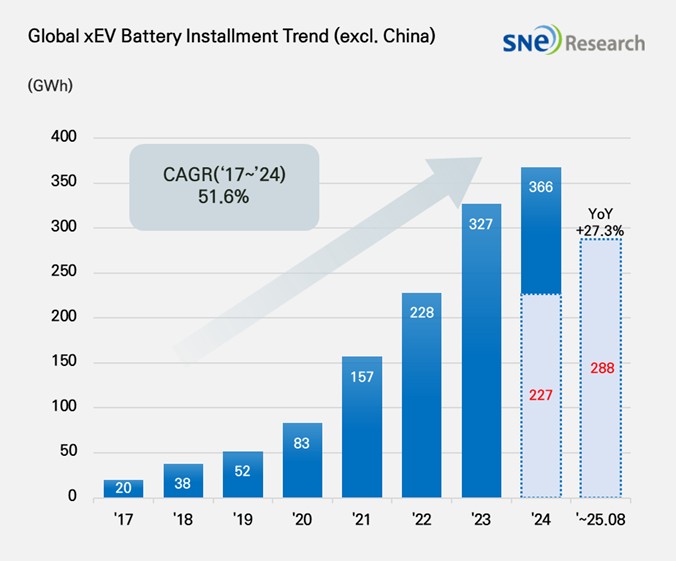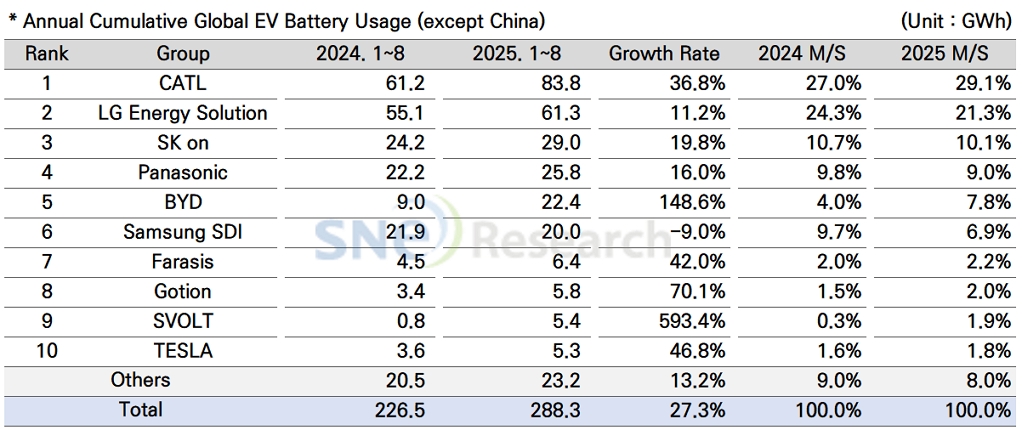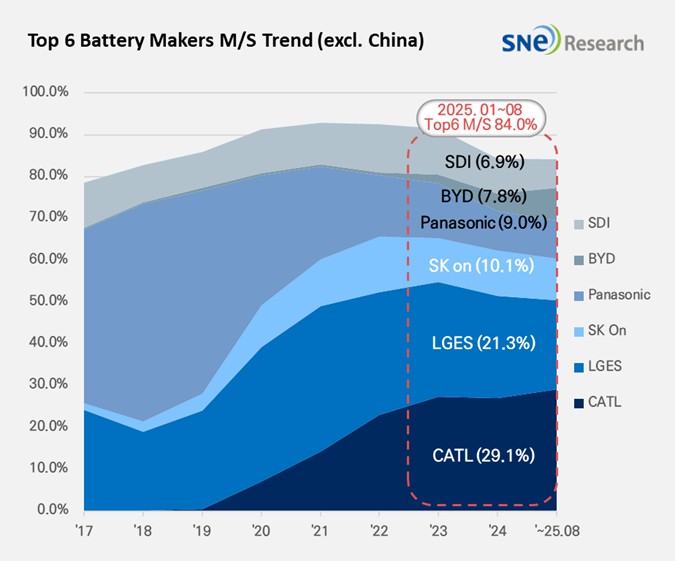From Jan to Aug in 2025, Non-Chinese Global[1] EV Battery Usage[2] Posted 288.3GWh, a 27.3% YoY Growth
-
From Jan to Aug in 2025, K-trio’s combined M/S recorded 38.3% (except China
market)
Battery installation for global
electric vehicles (EV, PHEV, HEV) excluding the Chinese market sold from Jan to
Aug in 2025 was approximately 288.3GWh, posting a 27.3% YoY growth.

(Source: Global EV and Battery Monthly Tracker – September 2025, SNE Research)
The combined market shares of LG Energy Solution, SK On, and Samsung SDI in global electric vehicle battery usage from Jan to Aug in 2025 reached 38.3%, a 6.5%p decline from the same period last year. LG Energy Solution ranked 2nd on the list with 11.2% (61.3GWh), while SK On took the 3rd position with 19.8% (29.0GWh) growth. On the other hand, Samsung SDI posted 9.0% (20.0GWh) degrowth.

(Source: Global EV and Battery Monthly Tracker – September 2025, SNE Research)
If we look at the usage of battery made by the K-trio in terms of sales volume of models, Samsung SDI’s battery was mainly supplied to BMW, Audi, and Rivian. BMW has Samsung SDI’s batteries in its major electrified models such as i4, i5, i7, and iX, and thanks to the overall increase in sales of those models, the usage of Samsung SDI’s battery by BMW consequently increased. In case of Rivian, although they recorded stable sales of R1S and R1T in the US, the newly launched standard range trim, to which Gotion’s LFP batteries are installed, has had a negative impact on the share of batteries supplied by Samsung SDI to Rivian. On the other hand, as Audi started selling Q6 e-Tron, built on the PPE platform, the usage of batteries recorded a 15.9% YoY growth.
SK On’s battery was installed to electric vehicles made by Hyundai Motor Group, Mercedes-Benz, Ford, and Volkswagen. Hyundai Motor Group has SK On’s battery in IONIQ 5 and EV 6 most, and the steady sales of VW ID.4 and ID.7 also contributed to an increase in the usage of batteries made by SK On. Despite a slowdown in sales of Ford F-150 Lighting, to which large-capacity batteries are installed, the increasing sales of Explorer EV has led to a 13.0% YoY growth in the usage of batteries made by SK On.
LG Energy Solution’s battery was mainly used by Tesla, Chevrolet, Kia, and Volkswagen. Due to a slowdown in sales of Tesla models, to which LG Energy Solution’s batteries are installed, the usage of LGES’ batteries by Tesla saw a 28.0% YoY decrease. On the other hand, thanks to favorable sales of Kia EV 3 in the global market and expanded sales of Chevrolet Equinox, Blazer, and Silverado EV, to which the Ultium platform was applied, in the North American market were regarded as a major drive behind the increasing usage of batteries made by LG Energy Solution.
Panasonic, which mainly supplies its batteries to Tesla, ranked 4th on the list with the battery usage of 25.8GWh. Panasonic has been speeding up the reshuffling of supply chain to focus on the North American market, in response to the recently fortified US tariffs on the Chinese batteries and raw materials. To be specific, Panasonic is working on lowering its dependency on the Chinese materials, expanding the procurement of local materials, and securing new material sources in order to increase the stability in battery production. These efforts are expected to lay a significant foundation for recovery in the usage of batteries made by Panasonic and maintaining its market share in the North American market.
Even in the global market excluding China, CATL remained top on the list with 36.8%(83.8GWh) YoY growth. Not only local Chinese OEMs, but many of major global OEMs also adopt CATL’s batteries for their electric vehicles.
BYD took 5th place on the list, posting 148.6%(22.4GWh) YoY growth. BYD, which manufactures both batteries and electric vehicles (BEV+PHEV) in-house, has been expanding sales of electric vehicles in various segments based on its strong price competitiveness. Not only in the Chinese domestic market but also in the overseas market, BYD has been rapidly solidifying its presence. In particular, BYD showed a notable expansion in the European market. In the 1st half of this year, the usage of BYD batteries in Europe recorded 8.6GWh, a 263.1% YoY increase.

(Source: Global EV and Battery Monthly Tracker – September 2025, SNE Research)
In the non-Chinese global battery market, regional demand characteristics and shifts in technology and supply strategies are deepening simultaneously, exerting multifaceted pressure on how battery companies respond. In North America, discussions around tighter IRA regulations and the expanded application of the Foreign Entity of Concern (FEOC) rule are prompting automakers to reshape their sourcing strategies to mitigate supply-chain risks. In particular, GM and Stellantis are leading moves toward expanding LFP-based mass-market models and transitioning to localized procurement within North America.
In Europe, expectations for a possible policy grace period for plug-in hybrid vehicles (PHEVs) in the second half of the year have raised interest in moderating the region’s heavy reliance on battery electric vehicles (BEVs) over the longer term. At the same time, battery manufacturers are accelerating not only technological competition centered on high-energy-density NCM products but also the mass-production shift toward LFP and LMFP chemistries to address the growing affordable-EV segment.
Amid this convergence of regulatory, technological, and regional-strategy shifts, Korean battery makers are pursuing mid- to long-term competitiveness through a dual strategy targeting both premium and mass-market segments, while expanding their customer portfolios and enhancing sourcing flexibility.
[2] Based on battery installation for xEV registered during the relevant period.

